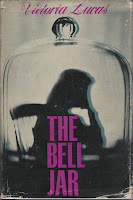According to the mimeographed schedule of Sylvia Plath's appointments while a Guest Editor at Mademoiselle, on 17 June 1953, she and the other Guest Editors to attend a tea at Vanity Fair (640 Fifth Avenue) at 3 pm, and then at 8 pm (probably) a film preview of Let's Do It Again(IMDb; Wikipedia) at Columbia Pictures, 729 Seventh Avenue, New York, New York. However this was the day the editors were all down with ptomaine poisoning so...
Anyway, in The Bell Jar, there is the most memorable scene before the ptomaine takes hold in the cinema:
The movie was very poor. It starred a nice blonde girl who looked like June Allyson but was really somebody else, and a sexy black-haired girl who looked like Elizabeth Taylor but was also somebody else, and two big, broad-shouldered bone-heads with names like Rick and Gil.
It was a football romance and it was in technicolour.
I hate technicolour. Everybody in a technicolour movie seems to feel obliged to wear a lurid costume in each new scene and to stand around like a clothes-horse with a lot of very green trees or very yellow wheat or very blue ocean rolling away for miles and miles in every direction.
Most of the action in this picture took place in the football stands, with the two girls waving and cheering in smart suits with orange chrysanthemums the size of cabbages on their lapels, or in a ballroom, where the girls swooped across the floor with their dates, in dresses like something out of Gone With the Wind, and then sneaked off into the powder-room to say nasty intense things to each other.
Finally I could see the nice girl was going to end up with the nice football hero and the sexy girl was going to end up with nobody, because the man named Gil had only wanted a mistress and not a wife all along and was now packing off to Europe on a single ticket. (1963: 43)
The point of this post is to ask you for your help as I'm not well-educated on 1950s cinema. Does anyone know the name of this film that Plath describes in the novel? Thank you for your help.
All links accessed 8 March 2016.


